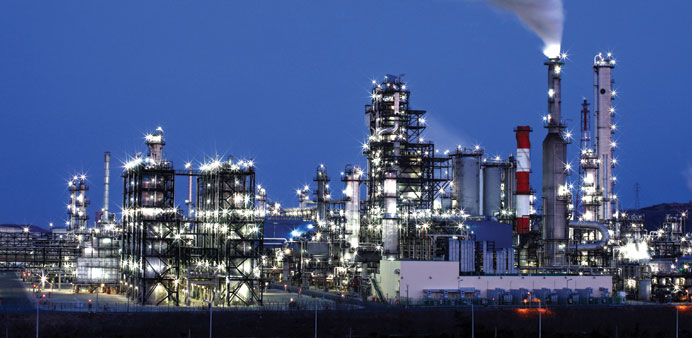SK Innovation Co’s Ulsan Complex oil refinery facilities operate at night in Ulsan, South Korea. Aramco holds about 63% in the project. The Saudi national oil company is also part of a group that’s building a processing plant in China and it teamed with Asia’s biggest refiner on another in Fujian province.
Bloomberg
Seoul
Saudi Arabia is spending generously now on Asian refiners to lock in its position as the region’s biggest supplier of oil for decades to come.
The Saudi national oil company is part of a group that’s building a processing plant in China and it teamed with Asia’s biggest refiner on another in Fujian province. Oil Minister Ali al-Naimi travelled to Beijing last month, highlighting the importance of the world’s second-biggest crude consumer to his country’s future. He also visited a South Korean refinery in which his country has a majority interest.
Pressure is rising on Saudi Arabia to hold on to market share in Asia as competitors including Iraq, Mexico and Russia make inroads. The kingdom, the world’s largest crude exporter, has cut price differentials on its crude to Asia 10 times in the past 18 months, while rivals followed with their own reductions.
“Saudi Arabia has been on the lookout for a lot more joint venture projects,” Suresh Sivanandam, a refining and chemical analyst at Wood Mackenzie Ltd in Singapore, said by phone. “They want to secure demand for their crude and that’s one way of increasing market share.”
Daily consumption of 31.2mn barrels in Asia this year will take the region’s demand above that in the Americas at 31.1mn barrels, according to the Paris-based International Energy Agency. Asia will account for two-thirds of the growth in global oil demand in 2015, the IEA says.
The flexibility of Saudi Arabian Oil Co, the state company known as Aramco, to raise or cut output on short notice along with stakes in refineries run by its customers gives it an advantage over rivals, according to Julian Lee, an oil strategist with Bloomberg. The company has capacity to produce 12mn bpd.
Aramco’s press office declined to comment in an e-mail.
Saudi Arabia, pumping near a record rate, already forced a slowdown in US shale production by leading the Organisation of Petroleum Exporting Countries in a policy of maintaining output to hold on to customers rather than cutting production to support prices. Shale oil drillers have reduced their rigs 21 weeks in a row and cut the total by more than half since October. West Texas Intermediate crude, the US benchmark, is down more than 40% from a high in June.
A joint venture between PetroChina Co, Aramco and Yunnan Yuntianhua Co is currently building a 260,000 bpd refinery in the southwest of the Asian nation. Aramco already manages a 280,000 bpd refinery and petrochemical complex in China’s Fujian province along with China Petroleum & Chemical Corp, known as Sinopec, and Exxon Mobil Corp.
Aramco is pursuing a “long-term growth strategy” and is seeking to invest more in China to help the Asian nation meet its energy needs, Khalid al-Falih, then the company’s chief executive officer, said in a speech in Beijing in March. The country is the largest oil consumer after the US.
Al-Falih has since replaced al-Naimi as chairman of Aramco and the company named Amin Nasser as interim CEO.
Al-Naimi led a meeting with Aramco officials and South Korean refinery executives in Seoul last month and visited S-Oil Corp’s Ulsan refinery, in which the Middle East producer holds about 63%. The company also owns about 15% of Japan’s Showa Shell Sekiyu KK.
In Vietnam, a 400,000 bpd plant will be jointly constructed by Aramco and PTT Pcl in Binh Dinh province, according to the Thai company’s 2014 annual report and the Dau Tu newspaper, which cited a project investment plan submitted to Vietnam’s industrial ministry in September.
Aramco’s refining strategy isn’t limited to Asia. The company owns half of Motiva Enterprises, which operates three plants in Texas and Louisiana with total refining capacity of about 1.1mn barrels a day.
“By investing in refining, they hope to find guaranteed output for their crude,” said Victor Shum, a Singapore-based vice president at IHS Inc, an industry consultant. “It has been part of their long-term strategy.”
Potential investments also include Indonesia. Pertamina Persero PT will join Aramco for a study to upgrade the Cilacap refinery this year, Wianda Pusponegoro, a spokeswoman at the state-owned Indonesian company, said last month.
“They definitely have deep pockets but they have to be selective about where to invest,” Wood Mackenzie’s Sivanandam said. “They are looking at the right markets like Vietnam and Indonesia.” Saudi Arabia also has used its pricing strategy to fend off rivals in Asia. Differential cuts set its Arab Light oil at a record discount of $2.30 a barrel for March supplies as it sought to defend market share.
Competitors followed. Petroleos Mexicanos, the national oil producer known as Pemex, sold its Isthmus light crude in February to Asian buyers at the biggest discount to the average of the benchmark Oman and Dubai grades since at least 1995. The gap between Iraq’s Basrah Light and Kuwait’s Export grades to Saudi Arabia’s Arab Medium has widened since March, data compiled by Bloomberg show.
“Iraq is increasing its production and exports and Russia is also trying to capture part of the market share,” Ehsan Ul-Haq, a senior analyst at KBC Energy Economics in London, said by phone. The Saudi investment strategy is “not only to defend their market share but also to expand their market share,” he said.



